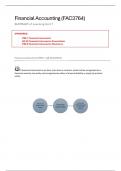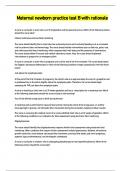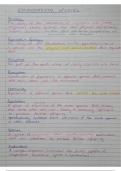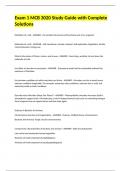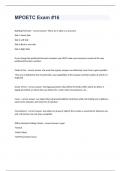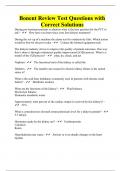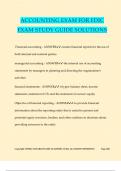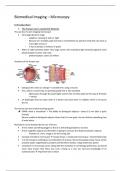Financial Accounting (FAC3764)
SUMMARY of Learning Unit 7
STANDARDS:
- IFRS 7 Financial Instruments
- IAS 32 Financial Instruments: Presentation
- IFRS 9 Financial Instruments: Disclosure
FINANCIAL INSTRUMENTS (IFRS 7, IAS 32 & IFRS 9)
A financial instrument is an item, born from a contract, which will be recognised as a
financial asset by one entity and recognised as either a financial liability or equity by another
entity.
Financial Financial
Asset of one
Financial liability/equity
entity Instrument of another
entiry
, Financial Assets
A financial asset is defined as cash, an equity instrument of another entity, a contractual
right to:
- Receive cash or another financial asset from another entity; or
- Exchange financial assets of financial liabilities with another entity under conditions
that are potentially favourable to the entity; or
- Certain contracts to be settled in the entity’s own equity instruments.
Examples:
Financial Assets Not Financial Assets
Cash Gold
Trade accounts receivables Inventory
Right to receive as many of the entity’s own Prepaid electricity
equity instruments
Right to receive as many of the entity’s own
equity instruments (market value)
FINANCIAL ASSETS: RECOGNITION
Initial recognition – recognised only when the entity becomes party to the contractual provisions
of the instrument.
FINANCIAL ASSETS: CLASSIFICATION
Four Formal
Classifications
Fair value through other Fair value through other
Fair value through profit comprehensive income comprehensive income
Amortised cost (AC)
or loss (FVPL) for debt instruments for equity instruments
(FVOCI-debt) (FVOCI-equity)
Financial Assets is classified by assessing:
- Its contractual cash flow characteristics
- The business model within which the financial asset is managed
SUMMARY of Learning Unit 7
STANDARDS:
- IFRS 7 Financial Instruments
- IAS 32 Financial Instruments: Presentation
- IFRS 9 Financial Instruments: Disclosure
FINANCIAL INSTRUMENTS (IFRS 7, IAS 32 & IFRS 9)
A financial instrument is an item, born from a contract, which will be recognised as a
financial asset by one entity and recognised as either a financial liability or equity by another
entity.
Financial Financial
Asset of one
Financial liability/equity
entity Instrument of another
entiry
, Financial Assets
A financial asset is defined as cash, an equity instrument of another entity, a contractual
right to:
- Receive cash or another financial asset from another entity; or
- Exchange financial assets of financial liabilities with another entity under conditions
that are potentially favourable to the entity; or
- Certain contracts to be settled in the entity’s own equity instruments.
Examples:
Financial Assets Not Financial Assets
Cash Gold
Trade accounts receivables Inventory
Right to receive as many of the entity’s own Prepaid electricity
equity instruments
Right to receive as many of the entity’s own
equity instruments (market value)
FINANCIAL ASSETS: RECOGNITION
Initial recognition – recognised only when the entity becomes party to the contractual provisions
of the instrument.
FINANCIAL ASSETS: CLASSIFICATION
Four Formal
Classifications
Fair value through other Fair value through other
Fair value through profit comprehensive income comprehensive income
Amortised cost (AC)
or loss (FVPL) for debt instruments for equity instruments
(FVOCI-debt) (FVOCI-equity)
Financial Assets is classified by assessing:
- Its contractual cash flow characteristics
- The business model within which the financial asset is managed

